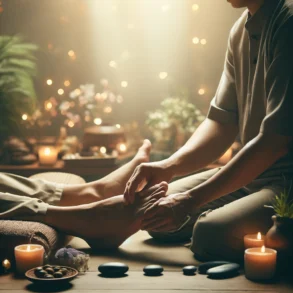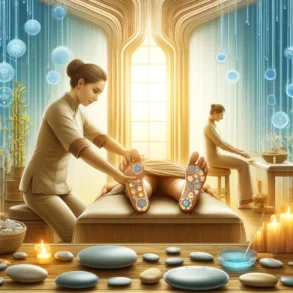Reflexology Healing Pressure
Are you aware of the fascinating world of reflexology? In the article, “Reflexology Healing Through Pressure Points,” you’ll learn about this ancient practice that promotes healing by stimulating specific points on your hands, feet, and ears. It’s a holistic approach to well-being that incorporates physical, emotional, and mental health. Transformative, calming, and surprisingly powerful, reflexology might just be the hidden gem you’ve been searching for in your wellness journey, promising a unique blend of relaxation and invigoration. So sit back, unwind, and prepare to be enlightened on the wonders of reflexology.

Understanding Reflexology
Reflexology is an alternative healing therapy that involves the application of pressure to specific points and zones on the feet, hands, or ears. These points correspond to different body organs and systems, and by pressing them, it’s possible to improve health and reduce stress through improved circulation and release of endorphins, the body’s natural painkillers.
What is Reflexology?
Reflexology is a therapeutic method that focuses on stimulating reflex points in your hands, feet, and ears. These points are believed to correspond to different organs and systems in your body. It’s grounded in the belief that when pressure is applied to these areas, it can promote healing and relieve symptoms in the related body part.
Brief History of Reflexology
Reflexology dates back to Ancient Egypt and China, thousands of years ago. It was used to promote health, treat diseases and was considered an integral part of life. The modern version of reflexology as we know it today, however, was developed in the early 20th century by Dr. William Fitzgerald who introduced the concept of ‘zone therapy’. Later, Eunice Ingham, a physiotherapist, developed the foot maps and specific techniques used in reflexology today.
Basic Principles of Reflexology
The basic principle of reflexology is that our body is interconnected and we can impact various areas and organs by applying pressure to particular points. These points are distributed along invisible lines or ‘meridians’ that run lengthwise throughout the human body. When energy flows freely along these meridians, it helps maintain good health. However, blockages or misalignments can lead to disease or discomfort, and this is where reflexology steps in.
Benefits of Reflexology
Reflexology offers a myriad of benefits, ranging from mental health to pain management. But it’s important to remember that reflexology is a complement to standard treatments – not a replacement.
Enhanced Mental Health and Well-being
By stimulating specific acupoints, reflexology helps to balance your body and mind, thus enhancing your mental health. It can boost mood, alleviate depression, and help in better managing emotional stress and tension.
Pain and Fatigue Management
Applying pressure to specific points can help alleviate various types of pain, including headaches, migraines, neck or back pain, and menstrual cramps. It can also help counter fatigue, enhance energy levels, and improve sleep quality.
Improved Blood Circulation
Reflexology helps to improve blood circulation in your body. It promotes the delivery of oxygen and essential nutrients to your body’s cells, which leads to better overall health.
Stress and Anxiety Reduction
The relaxing process of reflexology can lead to a significant reduction in stress and anxiety, promoting overall relaxation and calmness.

Reflex Points and Corresponding Body Parts
Reflexology employs detailed maps of these reflex points situated on your feet, hands, and ears to guide the healing process.
Foot Reflexology Map
The foot reflexology map is perhaps the most used in this practice. It suggests that every organ, gland, and body part is reflected in the feet. For instance, the tips of the toes correspond to the head and the heels to the lower back and intestines.
Hand Reflexology Map
In hand reflexology, different areas on your hands correspond to specific organs, glands, and body parts. For instance, the tips of the fingers represent the head, and the lower part of the palm corresponds to the lumbar region and the intestines.
Ear Reflexology Map
Ear reflexology is less common, but still valuable. Similar to hands and feet, different regions of the ear represent various organs and body parts – for example, the earlobes correspond to the head and heart.
Techniques in Reflexology
Different techniques in reflexology involve unique methods of applying pressure to reflex points, and each holds its unique benefits.
Thumb Walking Technique
This is a fundamental technique where pressure is applied using a “walking” motion of the thumb, allowing the practitioner to reach deeper reflex points and achieve better precision.
Finger Walking Technique
This technique is similar to thumb walking, but it involves using the fingers instead. It allows accessing hard-to-reach areas and applies a more gentle pressure, perfect for sensitive areas.
Hook and Backup Technique
This technique involves applying pressure, hooking the thumb or finger under a bone, and then backing it up to the previous position. It’s particularly useful in areas where reflex points are aligned closer to the bone.

Scientific Research on Reflexology
Scientific research corroborates the host of benefits reflexology can offer, yet it is also important to debunk certain myths surrounding this technique.
Research Supporting the Benefits of Reflexology
Research over the past few decades has found strong evidence highlighting the efficacy of reflexology in pain management, improvements in sleep and relaxation, and even benefits for patients undergoing cancer treatment.
Debunking the Myths around Reflexology
While reflexology offers numerous health benefits, it’s important to dispel any misconceptions. Reflexology is not a ‘cure-all’ and cannot diagnose diseases. It should be seen as a complementary therapy that operates alongside conventional treatments.
Reflexology and Traditional Chinese Medicine
Reflexology also draws on concepts from Traditional Chinese Medicine (TCM) such as Qi and Yin-Yang.
The Concept of Qi in Reflexology
In TCM and reflexology, Qi refers to a life force or energy that circulates within the body. Reflexology aims to clear blockages in the flow of Qi, facilitating overall well-being and health.
Yin and Yang Philosophy in Reflexology
The Yin-Yang theory, symbolizing balance and harmony, is heavily reflected in reflexology. This therapy aims to balance energy flow in the body, promoting harmony and therefore, better health.

Reflexology vs. Other Forms of Massage
While similar to many other massage types, reflexology distinguishes itself through a few key differences.
Differences Between Reflexology and Shiatsu
Both reflexology and Shiatsu are based on the concept of energy flow but whilst Shiatsu focuses on the entire body using rigorous pressure, reflexology is more gentle and concentrates solely on the hands, feet, and ears.
Contrasting Reflexology and Swedish Massage
Swedish massage is a full-body relaxation massage focusing on the superficial muscles, while reflexology is a targeted practice dealing with specific points and zones associated with various body organs and systems.
Comparison of Reflexology and Acupressure
Both reflexology and acupressure employ pressure points to promote health. However, acupressure covers the whole body while reflexology uses only the hands, feet, and ears.
Safety and Precautions in Reflexology
Despite its numerous benefits, reflexology is not suitable for everyone. Understanding the precautions is crucial to its safe application.
Who Can Benefit from Reflexology
Reflexology is beneficial to a broad audience ranging from the elderly to those suffering from various conditions such as migraines, insomnia, and menstrual issues. It’s also an excellent strategy for managing stress, promoting relaxation, and enhancing overall well-being.
When to Avoid Reflexology
However, reflexology should be avoided by people with foot ulcers, recent injuries, or certain heart conditions. Pregnant women should also seek advice from a healthcare professional before engaging in reflexology.
Potential Side Effects of Reflexology
Possible side effects might include light-headedness, emotional sensitivity, or tiredness right after a session. These usually resolve within a few hours.
Finding a Qualified Reflexologist
Observing the right qualifications and reviewing their expertise is very important when choosing a reflexologist.
Qualifications to Look For in a Reflexologist
Look for a reflexologist who has proper training and holds certification from a recognized organization. They should also follow a professional code of ethics and carry a professional indemnity insurance.
Questions to Ask a Potential Reflexologist
It’s smart to ask the potential reflexologist about their training, treatment plan, and experience with your specific issues. Also, determine their understanding of hygiene and safety protocols.
Experience with Reflexology: Personal Stories
While scientific research is crucial, personal stories often provide a relatable perspective to the benefits of reflexology.
Individual Experiences with Reflexology for Different Health Issues
Many people have reported positive experiences with reflexology for various health issues, ranging from migraines and digestive problems to hormonal imbalances and arthritis.
Testimonials on the Benefits of Reflexology
Testimonials have indicated the effectiveness of reflexology in improving relaxation, reducing stress, and enhancing overall well-being. Despite its ancient roots, reflexology continues to impact people’s lives positively.
Reflexology is an intriguing healing art with rich history and promising possibilities. Whether you’re seeking to relieve pain or enhance relaxation, incorporating reflexology into your routine could be a beneficial step to support your journey to healing and well-being.
